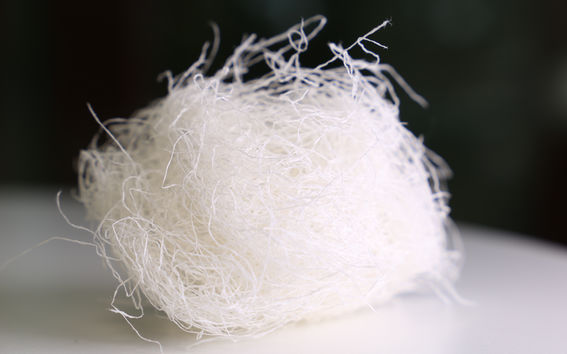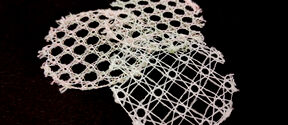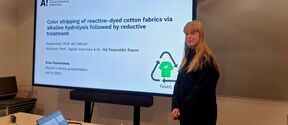Wood-based yarn captures hormones from wastewater

VTT and Aalto University have developed a wood-based cellulose fibre yarn that is an affordable solution for capturing pharmaceutical substances – especially ethinylestradiol in contraceptive pills – that would otherwise end up in bodies of water.
By attaching a cyclic sugar onto the surface of the cellulose fibre yarn, the research scientists were able to create a material that efficiently captures ethinylestradiol (EE2), a hormone used in contraceptive pills. The cyclic sugars are bonded chemically onto the surface of the yarn. The sugars form a pocket into which hydrophobic pharmaceutical substances seek to enter. This way, it only takes a few minutes for pharmaceutical compounds to become bound to the cyclodextrins coupled to the surfaces and cavities of the fibre. Test results demonstrate that one gram of fibre yarn can capture approximately 2.5 milligrams of the hormone.
'Hormone capture would be most effective in wastewater treatment plants and hospitals, since the wastewater in these facilities contains a higher concentration of the compounds. We are developing a wood-based affordable material that could be thrown into a tank in a wastewater treatment plant or used as a filter in a pipe connected to the tank. After some time, the material is collected mechanically. It is disposed of by incineration, but it is also possible to separate the pharmaceuticals and reuse the material,' describes VTT's Senior Scientist Hannes Orelma.
The development effort used wood-pulp-based fibre yarn that was manufactured using deep eutectic solvents (DES) in a method developed by VTT. DESes represent a new generation of organic solvents, some of which can be environmentally very friendly. This research used an environmentally friendly DES.
'It would be interesting to test how effectively the cellulose yarns can capture hormones and pharmaceuticals from wastewater at a larger scale,' states Orelma.
Hormones and other pharmaceutical agents ending up in bodies of water are a major problem in Central Europe and the United States, where the reported concentrations of oestrogen hormones have reached up to 0.83 micrograms per litre. These hormones are called endocrine disruptors, since they affect the gender of fish and turn male fish into females. The EU has identified pharmaceuticals in waters as a challenging problem, since wastewater treatment plants cannot capture the substances efficiently enough. At present, wastewater treatment plants capture pharmaceuticals by means of activated sludge tanks, but a portion of the compounds nevertheless escape the tanks and end up in bodies of water.
The development of the material started in 2015 as a collaborative effort between VTT and Aalto University. The development was funded by Tekes (currently known as Business Finland) under the Design Driven Value Chains in the World of Cellulose II project. At present, the design and development of the material is supported by the Academy of Finland and proceeds in the FinnCERES Materials Cluster that develops entirely new kinds of biomaterials. Clean air and water is one of the key research themes of FinnCERES.
VTT has patented the method and tested it at laboratory scale. The research results were published in BioMacromolecules in 2018: https://pubs.acs.org/doi/full/10.1021/acs.biomac.7b01765
More information:
Senior Scientist Hannes Orelma, VTT
+358 40 354 3143
hannes.orelma@vtt.fi
Read more news

Learning Centre opening hours during Christmas and year-end holidays
Thank you for the past year and have a wonderful holiday season!
Smart textiles are reshaping our understanding of materials – and interspecies communication
The PAST-A-BOT research project, funded by the European Research Council (ERC), is developing soft, intelligent textiles that could one day function as rescue robots, sound-sensing agricultural fabrics, or assistive clothing. At the same time, the project aims to rethink the way we approach materials research.
Master’s student showcases efficient color stripping of cotton fabrics
On December 9, master’s thesis student Elsa Vuorenmaa from the Textile Chemistry Group presented the results of her research on color stripping of reactive-dyed cotton fabrics.






